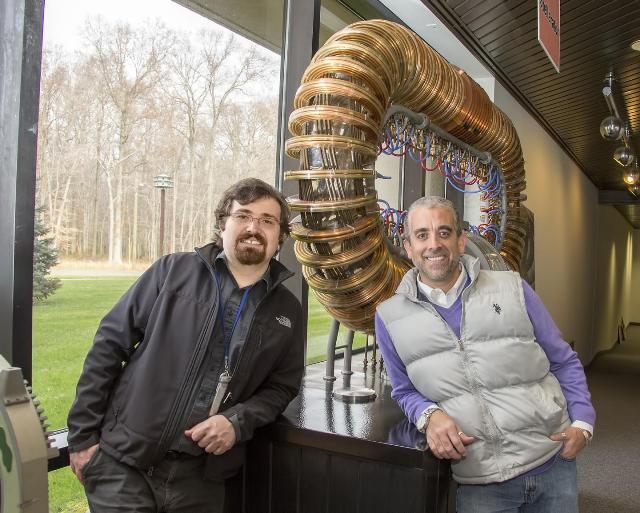Dec 23 2015
Physicists Luis Delgado-Aparicio and Egemen Kolemen of the U.S. Department of Energy's (DOE) Princeton Plasma Physics Laboratory (PPPL) have won a national scientific competition to conduct a full day of experiments on the DIII-D National Fusion Facility that General Atomics operates in San Diego for the DOE. The honor, known as the Torkil Jensen Award, is named after the late and internationally recognized scientist who was a member of the General Atomics Fusion Group for 44 years.
 Egemen Kolemen and Luis Delgado-Aparicio at PPPL. Credit: Elle Starkman/PPPL Office of Communications
Egemen Kolemen and Luis Delgado-Aparicio at PPPL. Credit: Elle Starkman/PPPL Office of Communications
The PPPL physicists will use their opportunity to test the recently proposed cause of the density limit, a daunting problem that keeps doughnut-shaped facilities called tokamaks from operating at peak efficiency. The cause, according to a theory advanced by PPPL physicist David Gates and colleagues at the Laboratory, lies in the tendency of bubble-like islands that form in the plasma that fuels fusion reactions to shed heat and grow exponentially -- a runaway growth that disrupts the crucial current that completes the magnetic field that holds the plasma together.
"We want to understand the physics of this island growth and see if it causes the density limit," said Delgado-Aparicio. "We want to be able to tell a really coherent story." This work is supported by the DOE Office of Science.
The theory holds that impurities kicked up from the interior walls of a tokamak collect inside the islands and cause them to radiate away their heat. Raising the density of the plasma increases the heat loss. Countering this cooling is heat that researchers pump into the plasma. But when the thermal balance in the islands shifts to net cooling, the islands rapidly expand and the plasma falls apart.
Testing in a number of ways
The researchers will test this hypothesis in a number of ways. Kolemen will inject heat directly into an island to see if that offsets the cooling effect and causes the island to shrink rather than grow. The experiments will also add pellets of fuel to the core of the plasma to see if the direct heating can allow the density to increase without incident. And neon and argon impurities will be inserted into the islands to investigate whether the direct heating can overcome the radiated cooling effect. "What we are after is a microscopic description of what limits the density," said Kolemen. "And if we are right the next step will be to try to eliminate the problem."
The experiments, to be conducted in the first quarter of 2016, are in keeping with the spirit of the Torkil Jensen Award, which allots DIII-D time for research with the "potential for transformational results." DIII-D is the nation's largest magnetic fusion program, and the facility draws more than 500 researchers and institutions from around the world each year.
Experiments that lead to an understanding of the density limit, a vexing puzzle for more than 50 years, could facilitate the development of fusion as a safe, clean, and virtually limitless source of energy for generating electricity.